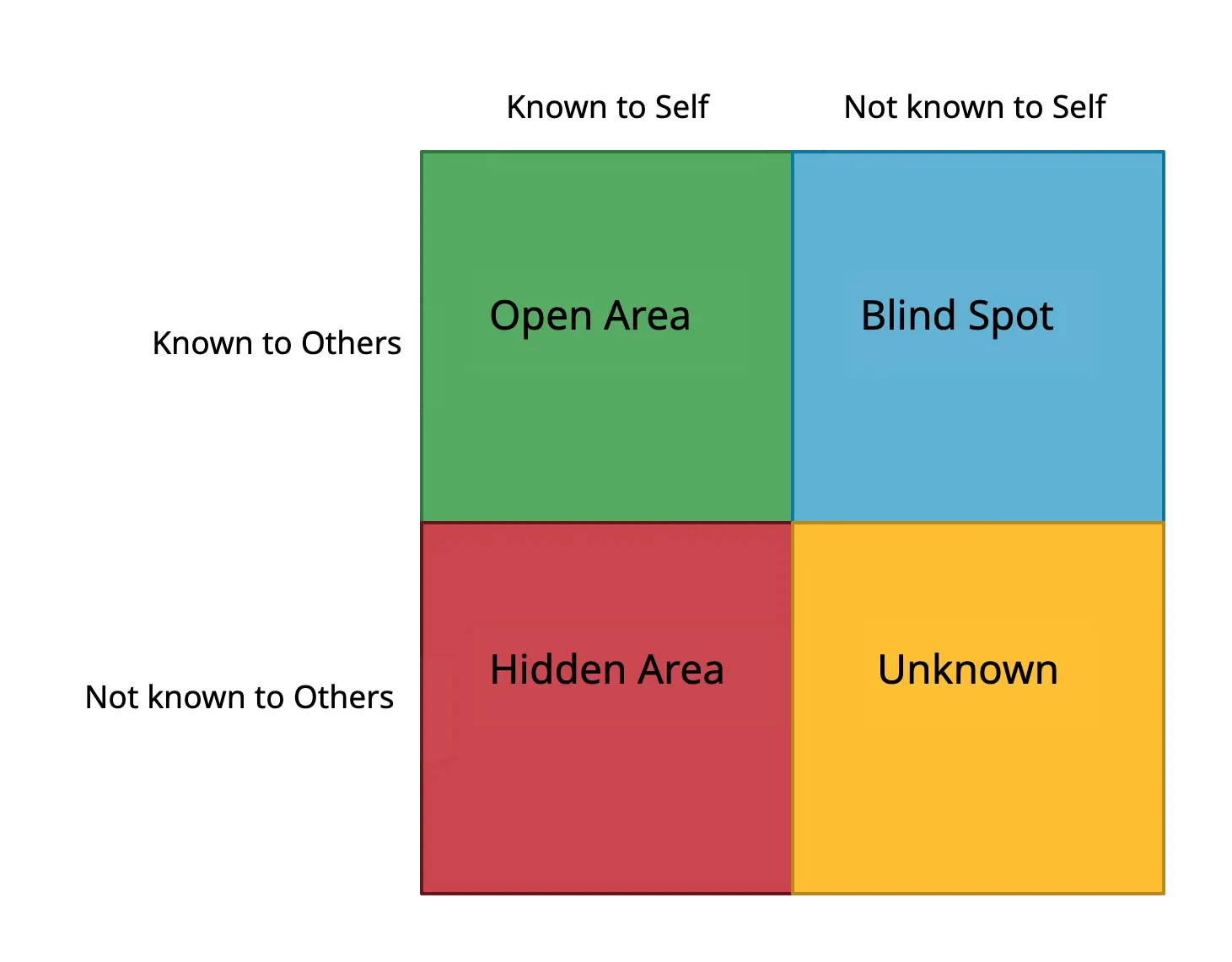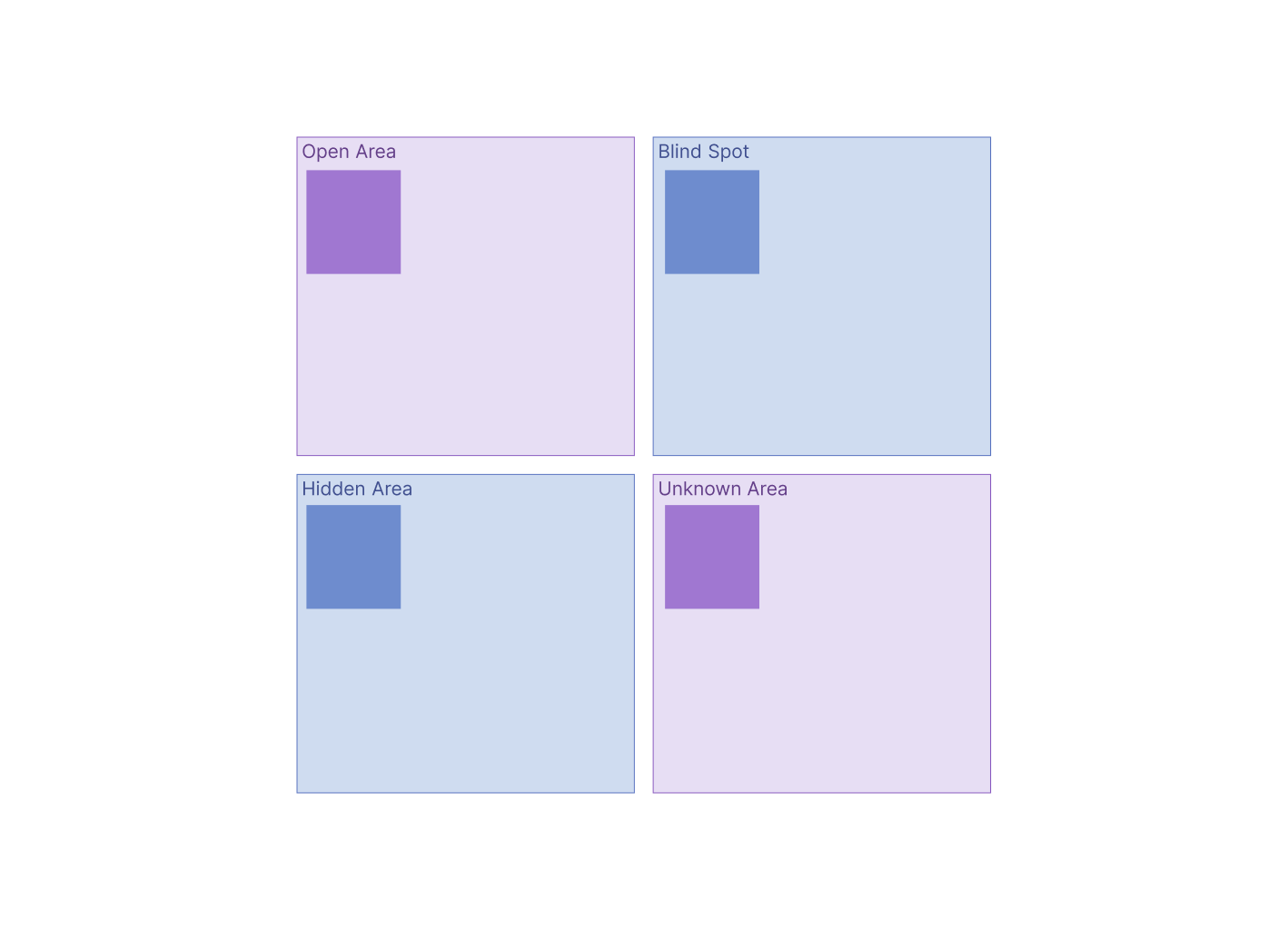Strong teams are built on trust, self-awareness, and clear communication. The Johari Window model is a powerful tool that helps individuals and teams better understand themselves and each other to improve collaboration. In this guide, we’ll explore how using the Johari Window theory can foster trust, enhance communication, and support personal and team growth.
What Is the Johari Window?
The Johari Window is a psychological model developed by Joseph Luft and Harrington Ingham in 1955 to improve self-awareness and understanding of how others perceive us. It divides personal awareness into four quadrants—Open, Blind Spot, Hidden, and Unknown—to help individuals explore themselves, enhance communication, and build stronger relationships.
What Are the 4 Quadrants of Johari Window?
The Johari Window model is divided into four distinct quadrants—Open, Blind Spot, Hidden, and Unknown—each representing different aspects of self-awareness and perception, and these become even easier to understand when viewed through simple Johari Window examples.

Johari Window Quadrant 1 - Open Self
The Open Self quadrant includes everything both you and others know about you—like your skills, behaviors, experiences, and feelings. It’s the foundation of trust and strong team relationships. The more this area grows, the easier it is to communicate and collaborate effectively.
To expand the Open Self quadrant:
- Share information openly – Talk about your role, experiences, and strengths during team interactions.
- Encourage open communication – Make it easy for everyone to express ideas and concerns.
- Create a safe, inclusive environment – When people feel respected, they’re more willing to share.
- Hold regular feedback sessions – Honest, constructive feedback helps uncover shared understanding.
Expanding this quadrant builds transparency, reduces misunderstandings, and leads to better teamwork.
Open Area Examples
The Open Area includes things you and others both know about you. These are strengths or habits that are recognized and appreciated by your team.
Scenario: During monthly check-ins, I discuss with my manager the skills we both recognize:
Strong project planning and organization
Effective communication with cross-functional teams
Ability to manage tight deadlines calmly
Recognizing these shared strengths helps me leverage them confidently in my work.
Johari Window Quadrant 2: The Blind Spot
The Blind Spot includes things others notice about us—but we don’t see ourselves. This might be a habit, tone, or attitude that’s clear to your team but invisible to you. If left unaddressed, blind spots can hurt communication and slow down progress.
Here’s how to reduce blind spots:
- Encourage honest feedback – Create a space where feedback is welcomed and seen as helpful, not critical.
- Keep it judgment-free – Make sure feedback is shared with care and a focus on growth.
- Ask for feedback regularly – Don’t wait for reviews—check in often to learn how others see you.
- Reflect and adjust – Take what you hear seriously, and look for ways to grow from it.
Tackling blind spots helps build stronger connections, clears up misunderstandings, and improves how teams work together.
Blind Spot Examples
The Blind Spot contains things others see in you that you don’t. Seeking feedback here can reveal areas for improvement.
Scenario: I ask colleagues for feedback on my collaboration style and discover:
I sometimes dominate discussions without realizing it
I could provide more detailed updates to remote team members
This feedback helps me adjust my behavior and strengthen relationships.
Johari Window Quadrant 3: Hidden Self
The Hidden Self includes things you know about yourself but choose not to share with others. This might be personal beliefs, feelings, fears, or experiences that you keep private.
Some key examples:
- Personal info – Preferences or values you feel aren’t relevant to share at work.
- Sensitive topics – Emotions, fears, or past experiences that might affect how you behave.
- Privacy vs. usefulness – It’s important to know what’s okay to keep private and what, if shared, could help the team understand you better.
Why hiding too much can be a problem:
- Miscommunication – Without full context, others may misunderstand your actions.
- Trust issues – Holding back can make teammates feel left out or unsure of your intentions.
- Lower team performance – Teams work best when important information is shared openly.
Finding the right balance between privacy and openness helps build trust and strengthens teamwork.
Hidden Area Examples
The Hidden Area is what you know about yourself but choose to keep private. Sharing selectively can help build trust and rapport.
Scenario: When mentoring new team members, I share:
My preferred methods for tackling complex problems
Past mistakes and lessons learned
My personal approach to managing stress
Sharing this thoughtfully helps others understand me better while maintaining appropriate boundaries.
Johari Window Quadrant 4: Unknown Area
The Unknown Area covers parts of yourself that neither you nor others know. These hidden factors can quietly influence your behavior.
They include:
- Hidden talents you haven’t discovered yet
- Habits shaped by past experiences without your awareness
- Deep emotions that affect how you react
How to explore this area:
- Self-reflection: Take time to think deeply and try new things to uncover hidden strengths.
- Feedback from others: Listen to what others notice about you that you might miss.
- Team activities: Group work can reveal hidden skills and behaviors.
- Professional support: Sometimes coaching or counseling helps uncover deeper, unconscious issues.
Exploring the Unknown Area can open the door to personal growth and new possibilities.
Unknown Area Examples
The Unknown Area includes hidden talents, undiscovered potential, or subconscious behaviors. Exploring this quadrant encourages growth and experimentation.
Scenario: I take on a new client-facing role and discover:
I enjoy public speaking and engaging audiences
I have a knack for creative problem-solving under pressure
I adapt quickly to unfamiliar situations
Exploring new challenges like this helps me grow in unexpected ways and uncovers strengths I wasn’t aware of.
How to Use the Johari Window Model
Step 1: Identify Personal Characteristics
The first step in using the Johari Window model is self-assessment. Reflect on your own behaviors, attitudes, and skills, and consider how you are perceived by others.
Step 2: Draw Diagram and Fill Quadrants
Create the Johari Window using a template to map out the four quadrants. Populate each area with information based on self-assessment and feedback from others.
Step 3: Define Your Goal
Set clear objectives for what you want to achieve with the Johari Window model, such as improving communication, increasing self-awareness, or building trust within the team.
Step 4: Ask for Feedback
Engage team members in providing honest and constructive feedback. Regularly review and update the Johari Window based on new insights and ongoing feedback.
Step 5: Using Creately to Implement the Johari Window Model
Use Creately’s drag-and-drop tools to create and customize your Johari Window diagram. Organize traits with sticky notes and color-coded labels on an infinite canvas. Creately AI helps suggest traits and spot patterns, speeding up analysis. Add comments and notes for context, then export or present your diagram with ease.
Self-Development Tips Using the Johari Window
Ask for regular feedback: Seek honest input from people you trust and listen without judgment. This helps shrink your Blind Spot and reveals how others really see you.
Be more open about yourself: Share thoughts, goals, and experiences in safe contexts to reduce your Hidden Area and let others know the real you.
Reflect on your behavior: Spend time journaling or reviewing patterns in your actions. Feedback can highlight strengths and areas for growth.
Try new experiences: Step out of your comfort zone to uncover hidden abilities and explore parts of your Unknown Area.
Practice vulnerability: Admit mistakes and share ambitions. Being genuine builds trust and encourages others to open up.
Work with a coach or mentor: Professional guidance can help uncover deeper emotions or unconscious behaviors, supporting personal growth.
Free Johari Window Examples to Get a Headstart
Johari Window Template
AI Johari Window Template
Johari Window For Community Engagement
Johari Window Template to Improve Soft Skills
Personal Development Johari Window
Resources
Kapur, R. (2023). Understanding the Relevance of Johari Window. [online] Research Gate. Available at: https://www.researchgate.net/publication/376958357_Understanding_the_Relevance_of_Johari_Window.
Swart, J. (2022). The Johari Window as a Coaching Tool to Create Awareness. [online] ResearchGate. Available at: https://www.researchgate.net/publication/365374732_The_Johari_Window_as_a_Coaching_Tool_to_Create_Awareness.
Esposito, R.P., Mcadoo, H. and Scher, L. (1978). The Johari Window Test: a Research Note. Journal of Humanistic Psychology, [online] 18(1), pp.79–81. doi:https://doi.org/10.1177/002216787801800113.
FAQs About the Johari Window Model
What are the main goals of the Johari Window model?
The main goals of the Johari Window model are:
Increase self-awareness: Understand your behaviors, strengths, and areas for growth.
Enhance interpersonal understanding: Learn how others perceive you and how you perceive yourself.
Build trust within teams: Encourage open communication and transparency.
Reduce blind spots: Identify behaviors or traits you may not be aware of but others notice.
Foster personal and professional development: Support growth through feedback, reflection, and self-disclosure.
What is the history of Johari Window model?
When to use the Johari window?
What are the benefits of Johari Window?
The benefits of using the Johari Window include:
Improved communication: Clearer understanding of yourself and others reduces misunderstandings.
Stronger relationships: Building trust through transparency and openness.
Better teamwork: Teams collaborate more effectively when blind spots are addressed.
Enhanced self-awareness: Recognize hidden strengths and areas for improvement.
Guided personal growth: Provides a structured approach for self-development and feedback integration.
How does the Johari window work?
Who can use the Johary Window model?
What are the 56 adjectives of the Johari Window?
The 56 adjectives of the Johari Window are descriptive traits used to help individuals identify and reflect on their personality characteristics. They are selected by yourself and others to populate the quadrants of the Johari Window.
The 56 adjectives are: able, accepting, adaptable, bold, brave, calm, caring, cheerful, clever, complex, confident, dependable, dignified, empathetic, energetic, extroverted, friendly, giving, happy, helpful, idealistic, independent, ingenious, intelligent, introverted, kind, knowledgeable, logical, loving, mature, modest, nervous, observant, organized, patient, powerful, proud, quiet, reflective, relaxed, religious, responsive, searching, self-confident, sensible, sentimental, shy, silly, smart, spontaneous, sympathetic, tense, trustworthy, warm, wise, witty, and youthful.







